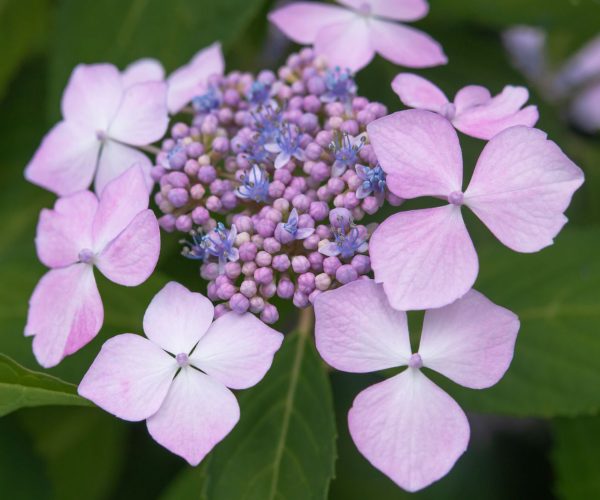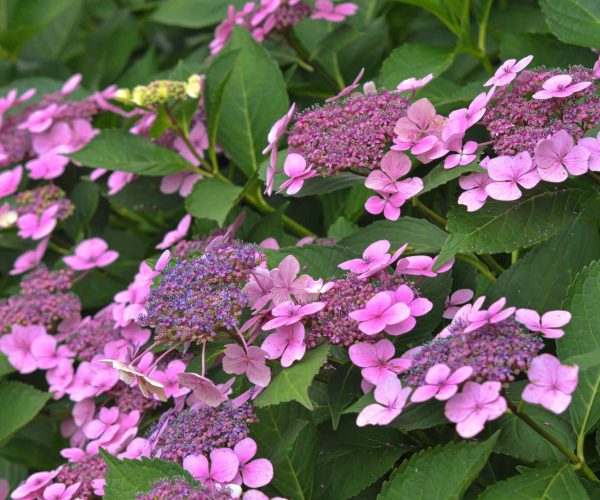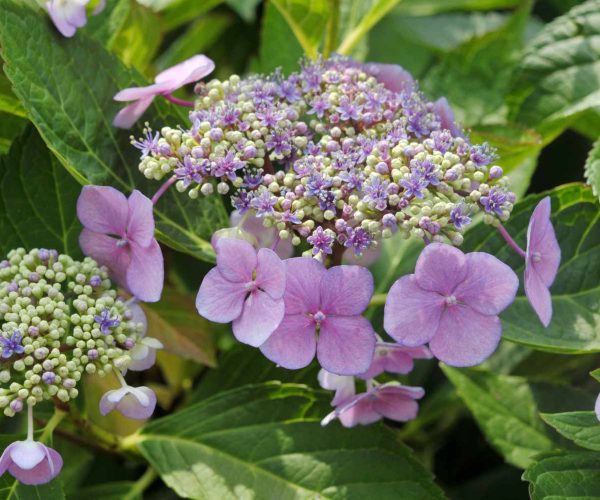Lacecap hydrangeas are a type of hydrangea with flower heads that resemble flat caps with frilly edges. It belongs to the bigleaf hydrangea species, known scientifically as Hydrangea macrophylla. This species is native to Japan. All lacecap hydrangeas have a central cluster of small florets surrounded by larger, showier flowers. However, these shrubs can differ in size, bloom color, and the time they flower. The leaves of lacecap hydrangeas are wide, dark green, and serrated. They provide a lush backdrop for large, flat flower heads. These shrubs grow quickly, typically reaching 2 feet or more in height each year.
The best times to plant lacecap hydrangeas are in the fall or early spring. However, these flowers can sometimes disappoint gardeners by not producing flowers. To resolve this issue, it is important to understand the possible reasons why your lacecap hydrangea might not be blooming. Here are the main reasons your lacecap hydrangea may not be flowering.
Plant Descriptions
Plant Type: Shrub
Scientific Name: Hydrangea macrophylla
Common Name: Lacecap Hydrangea
Family: Hydrangeaceae
Season: Summer, fall
Toxicity: Toxic to humans and pets
Lack of Sunlight
Lacecap hydrangeas thrive in full sunlight to partial shade. They even grow best with the morning sun and afternoon shade. If the plants are in too much shade, they may not receive enough light to produce blooms. On the other hand, excessive direct sunlight can stress the plants. This stress causes them to conserve energy instead of blooming. For optimal blooming, lacecap hydrangeas need at least half a day’s worth of sunlight.
Nutrient Imbalance
Timing and type of fertilization play a crucial role in the blooming of hydrangeas. While these plants need some nutrients, excessive nitrogen can lead to vigorous leaf growth at the expense of flowers. To encourage abundant blooms, it’s best to use a balanced slow-release fertilizer with high phosphorus content. Similarly, it is best to feed early in the spring. Additionally, avoid fertilizing in late summer, as this can stimulate tender new growth that may be vulnerable to winter damage.

Watering Issues
Lacecap hydrangeas thrive in consistently moist soil, as both under and overwatering can stress the plants and reduce their flowering potential. The soil should be kept evenly moist yet well-draining. Similarly, it is better to water deeply but less frequently than to sprinkle water shallowly regularly. If the leaves are wilting or scorching, it is a sign that the plant is experiencing water stress.
Soil Quality
Hydrangeas thrive in rich, well-draining soil that does not become waterlogged. If the soil quality is poor, the hydrangeas will not grow well. Similarly, you can add compost to the soil which can improve its fertility and structure. It is also important to check the soil’s pH level. Hydrangeas prefer slightly acidic conditions for optimal growth.
Cold Weather
Cold weather is also another important factor that can prevent lacecap hydrangeas from flowering, especially when they experience late frosts after budding. To protect these plants from extreme cold and potential bud loss, mulching or wrapping them in burlap during harsh winters can provide valuable insulation. Gardeners in areas with severe winter conditions may want to choose varieties that are more cold-hardy to ensure better resilience.
Improper Pruning
Improper pruning is one of the most common reasons that lacecap hydrangea would not bloom. All of these plants flower on old wood, which simply means the flower buds form during the previous growing season. If you prune too late in the season or cut back too much, you might remove important buds. This can lead to fewer flowers the following year. To avoid this, deadheading of the spent blooms should be done immediately after flowering. Additionally, any heavy pruning should be done after the blooming period has ended.
Also read: Why Isn’t My Flowering Ginger Plant Blooming? Common Issues Explained
Deer Damage
Hydrangeas are especially at risk during late winter and early spring, a time when deer have fewer food options and are more inclined to feast on garden plants. So, gardeners in rural or suburban areas should be aware that deer are particularly attracted to the soft, tender new leaves and delicate flower buds of hydrangeas. When these graceful plants are grazed upon, it can lead to a loss of flowers for the entire growing season. To safeguard your hydrangeas, consider implementing various protective measures, such as deer repellents, physical barriers, or other deterrents to keep deer away.
Young Plants
Larger hydrangeas are often more established and can produce blooms in their first year after planting. On the other hand, newly planted hydrangea shrubs usually take 2 to 5 years to start blooming. Although these hydrangeas may take longer to bloom, they often adapt better to their new environment. If you choose smaller plants, you can enjoy watching them grow over time. Each hydrangea will develop at its own pace, so give them the care they need and wait for the beautiful flowers to appear.

Pests and Diseases
Lacecap hydrangeas can be affected by fungal diseases like bacterial wilt, blight, leaf spot, and powdery mildew. To help prevent these diseases, it’s important to space the plants apart and avoid watering them from above. These hydrangeas also attract aphids, which are small insects that can harm the plants. If there are too many aphids, using neem oil or insecticidal soap can help get rid of them and keep the plants healthy.
Conclusion
In conclusion, Lacecap hydrangeas are lovely shrubs that need special care to grow well and produce their unique flat, frilly flowers. To help them bloom successfully, you should give them the right amount of sunlight, use nutrient-rich soil, keep the soil consistently moist, and protect them from cold weather and deer. Similarly, make sure not to use too much fertilizer and pay attention when you prune, as improper timing can result in a diminished bloom. It’s important to be patient with younger plants, as they may take a few years to bloom fully. By taking care of any pest or disease problems, you can enjoy your beautiful lacecap hydrangeas for many years.
Frequently Asked Questions
1. What are Lacecap Hydrangeas?
Lacecap hydrangeas are a type of hydrangea with flower heads that resemble flat caps with frilly edges. They have a central cluster of small florets surrounded by larger, showier flowers.
2. What kind of environment does this plant thrive in best?
They grow best in full sun to partial shade, with morning sun and afternoon shade. They prefer rich, well-draining, slightly acidic soil.
3. How should I water lacecap hydrangeas?
Water your hydrangeas deeply but less frequently. Similarly, make sure to keep the soil consistently moist without waterlogging it.
4. Why is pruning important for lacecap hydrangeas?
If you prune too much or too late, you might cut off flower buds, which can lead to fewer flowers. To keep your garden looking bright, make sure to remove dead flowers right after they fade and prune heavily only after the blooming season is over.
5. What should I do if my lacecap hydrangea experiences cold weather damage?
To protect lacecap hydrangeas from cold, especially late frosts, mulch the base or wrap the plant in burlap to insulate it during harsh winters.
Also read: How Can I ensure Healthy and Thriving Moonflowers in My Garden?
